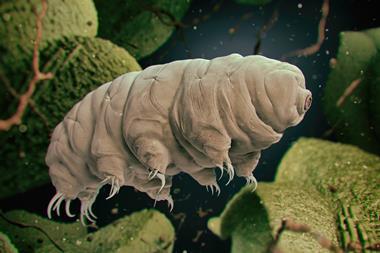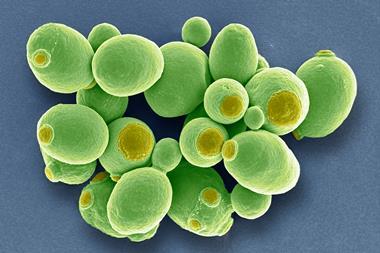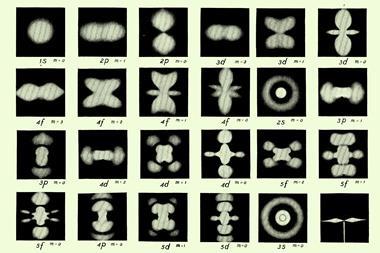Finding superposition in the building blocks of life
It’s one thing to know that your basic fabric, your flesh and blood, is fundamentally quantum mechanical. It’s another thing to see it.
But that’s what a new experiment has just shown. In a recent preprint Markus Arndt of the University of Vienna and coworkers have demonstrated quantum interference of ‘matter waves’ made from a natural peptide, the bacterial ionophore that forms cation-conducting channels in biological membranes. The peptide was extracted from the soil bacterium Bacillus brevis and formed into molecular beams that show wavelike properties, undergoing interference when sent through a diffraction grating.
But that’s what a new experiment has just shown1. In a recent preprint Markus Arndt of the University of Vienna and coworkers have demonstrated quantum interference of ‘matter waves’ made from a natural peptide, the bacterial ionophore that forms cation-conducting channels in biological membranes. The peptide was extracted from the soil bacterium Bacillus brevis and formed into molecular beams that show wavelike properties, undergoing interference when sent through a diffraction grating.
In one sense this is no surprise. Composed of just 15 amino acids and weighing 1,882 atomic mass units, gramicidin A is at least five times smaller than the synthetic molecules (perfluoroalkyl porphyrins) that Arndt and his colleagues used in earlier molecular interference experiments. Those studies in turn scaled up matter-wave interference that Arndt and a team from Vienna first demonstrated with C60 molecules 20 years ago. This previous work proved that the quantum interference effects long known for fundamental particles apply also to objects at the molecular scale. Wavelike diffraction of electrons and neutrons is now so routine a tool for structure determination and microscopy that it barely warrants comment.
In one sense this is no surprise. Composed of just 15 amino acids and weighing 1,882 atomic mass units, gramicidin A is at least five times smaller than the synthetic molecules (perfluoroalkyl porphyrins) that Arndt and his colleagues used in earlier molecular interference experiments2. Those studies in turn scaled up matter-wave interference that Arndt and a team from Vienna first demonstrated with C60 molecules 20 years ago3. This previous work proved that the quantum interference effects long known for fundamental particles apply also to objects at the molecular scale. Wavelike diffraction of electrons and neutrons is now so routine a tool for structure determination and microscopy that it barely warrants comment.
Interference with molecular ‘matter waves’, however, shows that the wavelike properties predicted for matter by Louis de Broglie in 1924 – a prediction that led Erwin Schrödinger to formulate his quantum-mechanical wave equation – persist at least to this scale. One key question is how large can objects get before this quantum waviness gives way to classical behaviour, where the objects act like the Newtonian entities we see around us, with definite trajectories and locations in space.
Duality check
Quantum interference is associated with the familiar notion of wave-particle duality, which is generally taken to mean that sometimes quantum objects can behave like waves and sometimes like particles. It is at its most striking when quantum particles are fired one at a time through a double slit, producing the light and dark bands of an interference pattern on a detection screen at the other side (where ‘light’ implies many particle impacts). This phenomenon is often said to show that the particles ‘pass through both slits at once’, since that seems to be the only way a particle can interfere with itself.
It’s a misleading description for two reasons. First, it insists on retaining a particle picture for what is really a wave effect. Second, it ignores the fact that quantum mechanics does not trace particle trajectories, but only predicts what we will see. And what we see are the interference bands building up over time from individual particle impacts. The ‘waves’ aren’t a description of an entity, but a way to rationalise what we observe in terms of familiar classical concepts.
Practical limits
Although gramicidin A is far from the largest molecule that has been shown to interfere, it poses particular challenges because, like most biomolecules, it is rather fragile. Volatilising peptides to make a molecular beam can all too readily break them apart or ionise them. Arndt and colleagues succeeded by using ultrashort pulses of ultraviolet laser light to evaporate the molecules from a carbon surface. They carried the molecules in a stream of argon or helium gas, sending the beam through three diffraction gratings to the detector, where the researchers measured interference fringes. In argon, the beams have an estimated de Broglie wavelength of 350×10-15m, which is 10,000 times smaller than the radius of the molecules.
‘Our experiments show that quantum phenomena can be observed with [the] building blocks of life’, Arndt and colleagues say. They plan now to try it with full-blown proteins and fragments of DNA. But where might this end?
Most quantum theorists now believe that the limits are only practical, not fundamental. That’s to say, there’s nothing in principle to prevent quantum effects, such as interference, entanglement and superposition, from being manifested at any scale; it’s just that they become undetectable. For one thing, the de Broglie wavelength of a baseball is around 10-34m, so how you’d spot its interference isn’t clear. But also, as objects get more massive it becomes all but impossible to prevent them becoming entangled with their environment, leading to a smearing out of the quantum properties and a loss of the coherence in the quantum-wave nature. This decoherence is thought to usher in classical-like behaviour, since it favours precisely those degrees of freedom that classical entities exhibit: no more superpositions of quantum states, say. Decoherence was demonstrated beautifully in the C60 matter-wave experiments as the pressure of background gas was increased.
Still, there may be some way to go yet. Ignacio Cirac and colleagues have proposed an experiment to place viruses, and perhaps even complex organisms such as tardigrades, in quantum superpositions. There’s no reason to think that quantum ends before life begins.
Still, there may be some way to go yet. Ignacio Cirac and colleagues have proposed an experiment to place viruses, and perhaps even complex organisms such as tardigrades, in quantum superpositions4. There’s no reason to think that quantum ends before life begins.

















No comments yet